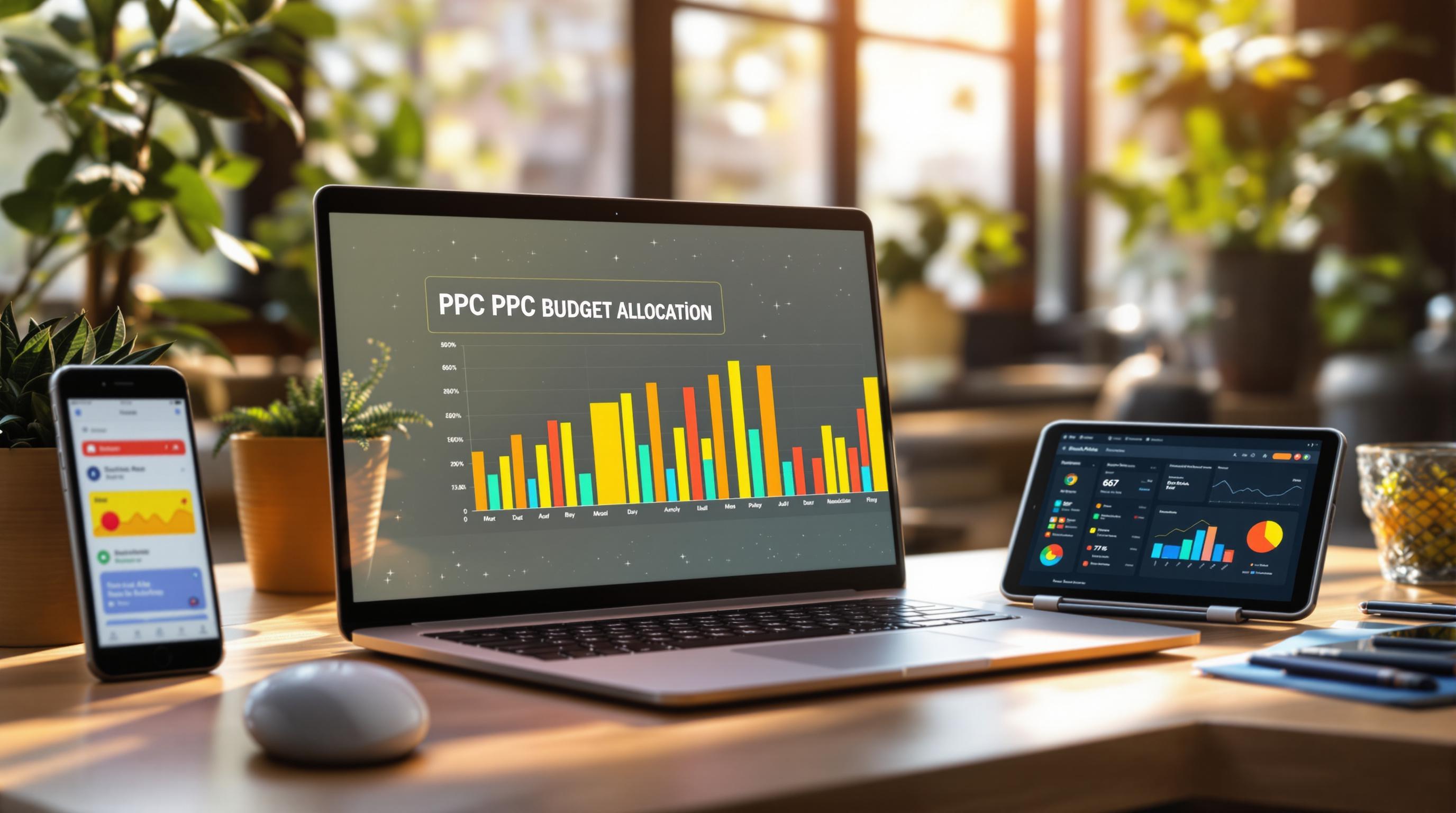Balancing short-term PPC wins with long-term growth is key to successful campaigns. Short-term tactics, like seasonal promotions, drive quick conversions, while long-term efforts, like brand building, ensure sustainable growth. Here's how to align both approaches:
- Short-Term Focus: Quick wins like flash sales, retargeting, and time-limited offers boost immediate ROI.
- Long-Term Goals: Metrics like Customer Lifetime Value (CLV) and brand awareness ensure lasting impact.
- Budget Split: Allocate 60-70% to short-term campaigns, reserving 30% for long-term strategies.
- Data Insights: Use short-term results to refine long-term targeting and bidding strategies.
| Timeframe | Focus Areas | Key Metrics |
|---|---|---|
| Short-term | Sales, CTR tweaks | ROAS, CPC, Conversions |
| Long-term | Brand value, customer retention | CLV, brand mentions |
Related video from YouTube
Setting Clear Long-Term PPC Goals
Establishing well-defined goals is essential for driving consistent growth while maintaining the flexibility to adapt in the short term. Long-term goals act as the backbone of a PPC strategy, helping you integrate short-term wins into a broader framework.
Key Long-Term Success Metrics
To measure the lasting impact of your PPC campaigns, focus on metrics that highlight sustained performance. Metrics like Customer Lifetime Value (CLV), brand recognition, and Return on Ad Spend (ROAS) provide insights into how your efforts are shaping long-term results [1][2].
| Metric Type | What to Track | Why It Matters |
|---|---|---|
| Brand Growth | Search volume, social mentions | Tracks market presence |
| Customer Value | CLV, retention rates | Evaluates long-term profitability |
| Campaign Health | ROAS, impression share | Reflects consistent performance |
Once you've identified the metrics that matter most, the next step is ensuring they align with your broader business goals.
Matching PPC Goals to Business Needs
For PPC campaigns to deliver meaningful results, they need to be closely tied to your business objectives. This requires careful planning and regular performance reviews [4].
Key areas to focus on:
- Data-Driven Decision Making: Use tools like those from the Top PPC Marketing Directory to improve bid management and keyword research, ensuring your decisions are backed by data.
- Continuous Optimization: Regularly review campaign performance and use A/B testing to refine your strategies, keeping long-term goals in sight [5].
- Budget Allocation: Dedicate 70% of your budget to proven strategies while reserving 30% for testing new approaches to drive future growth.
Adopting SMART objectives (Specific, Measurable, Achievable, Relevant, Time-bound) ensures your PPC goals align with business priorities. For example, if you're targeting market expansion, set a clear objective like increasing brand awareness by 20% within the next quarter through focused PPC efforts [4][5].
With these long-term goals in place, the next step is to implement short-term tactics that complement and support these objectives.
Quick PPC Wins: Short-Term Tactics That Work
Focusing on long-term goals is essential, but short-term PPC tactics can deliver quick results while offering valuable data to refine your broader strategies. Here's how you can achieve immediate impact without sacrificing your brand's future growth.
Best Short-Term PPC Methods
Short-term PPC strategies are all about creating immediate results. Below are some methods that can help you see quick improvements:
Seasonal Campaign Optimization
Use high-intent keywords tied to specific seasons, holidays, or events (e.g., "Valentine's Day gifts" in February) to capture peak demand and drive conversions [2].
Strategic Retargeting
Run call-only retargeting ads aimed at users who previously contacted you by phone. This approach provides a direct route to conversion for prospects already showing interest [5].
| Campaign Type | Target Audience | Expected Outcome |
|---|---|---|
| Call-Only Retargeting | Previous Callers | Higher conversion rates |
| Seasonal Promotions | Event-specific Searchers | Boost in short-term sales |
| Flash Sales | High-intent Prospects | Quick spike in conversions |
Time-Limited Offers
Create urgency with promotional campaigns that have clear deadlines. These campaigns encourage users to act quickly while staying in line with your brand's messaging [1].
Smart Budget Distribution
Proper budget management is key to balancing short-term wins with steady, long-term results. Flexibility and regular monitoring are essential.
Strategic Budget Split
Dedicate most of your budget (around 60-70%) to short-term performance campaigns, while keeping the remainder for long-term efforts [5].
Performance-Based Adjustments
Review campaign performance daily. Increase bids for high-performing keywords and cut back on underperforming ones to ensure you're getting the best ROI [2].
Automated Bid Management
Use AI-driven bidding tools to streamline spending and improve efficiency, making it easier to focus on overall campaign goals.
sbb-itb-89b8f36
Using Short-Term Results to Improve Long-Term PPC
Short-term strategies can do more than just deliver fast results - they can provide valuable insights to shape and improve your long-term PPC campaigns.
Turning Short-Term Data into Long-Term Gains
Pay close attention to metrics like return on ad spend (ROAS), customer acquisition cost (CAC), and customer lifetime value (CLV). These numbers can guide decisions that lead to more sustainable campaign success.
Keyword Performance Analysis
Identify keywords that drive the best conversions at the lowest cost. Keep these high-performing terms in your long-term strategy while scaling back on those that underperform.
| Metric Type | Short-Term Impact | Long-Term Application |
|---|---|---|
| Click-Through Rate | Gauges immediate engagement | Fine-tune keyword selection |
| Conversion Rate | Measures quick ROI | Improve audience targeting |
| Cost-per-Click | Assesses bid effectiveness | Adjust bidding over time |
Audience Targeting Adjustments
Use short-term insights into user demographics and behavior to fine-tune your audience segmentation for future campaigns.
"The key to PPC success lies in understanding your audience, offering them value through your ads, and continuously optimizing your campaigns based on performance data." - AdLeaks Team [3]
Combining Short and Long-Term Campaign Tactics
Strategic Adaptation
If a specific ad copy or call-to-action drives strong results in short-term efforts, incorporate it into your long-term campaigns while staying consistent with your brand's voice.
Testing and Optimization
Features like Google Ads' "Drafts & Experiments" let you test ideas in a controlled way before committing them to your broader strategy.
Boosting Quality Scores
A low Quality Score (below 5) can raise costs by as much as 400% per click. Use short-term findings to improve:
- Keyword relevance: Stick to terms proven effective in short-term tests.
- Landing page experience: Refine pages based on quick performance reviews.
Regular Performance Reviews
Set up weekly reviews and monthly budget evaluations to balance immediate wins with long-term growth. This approach helps you spot trends and make smarter adjustments over time.
Measuring PPC Success Across Time Periods
Tracking performance over different timeframes helps ensure that short-term achievements contribute to your overall growth goals.
PPC Performance Tracking Tools
Google Analytics and Google Ads are essential for monitoring key metrics like click-through rates (CTR), cost-per-click (CPC), and conversion rates. These tools provide the baseline for most PPC tracking setups.
For deeper insights, specialized tools from the Top PPC Marketing Directory offer advanced features:
| Tool | Key Features | Best For |
|---|---|---|
| Databox | 100+ tool integrations, customizable dashboards | Cross-platform analytics |
| Adzooma | Machine learning for optimization, automated tasks | Real-time adjustments |
| MarinOne Search | AI-driven bid management, cross-platform tracking | Multi-channel campaigns |
| Ruler Analytics | Visitor-level tracking, revenue attribution | Lead generation tracking |
"The difference between wasted ad spend and soaring ROI often comes down to the tools you use to analyze performance." - Databox
Key Metrics to Watch:
- Long-term metrics: Customer Lifetime Value (CLV), brand awareness indicators
- Financial metrics: Return on Ad Spend (ROAS), Cost Per Acquisition (CPA)
Using the right tools is just the start - consistent review cycles are crucial for maintaining and improving performance.
Regular Performance Reviews and Updates
Managing a successful PPC campaign requires frequent and structured evaluations. Here's how to stay on top of your campaigns:
- Daily checks: Monitor spending and conversions to catch any immediate issues.
- Weekly reviews: Dive into KPIs, analyze A/B test results, and refine strategies.
- Monthly assessments: Look at ROAS, audience targeting, and budget allocations to ensure long-term alignment.
Did you know PPC traffic converts 50% better than organic? This highlights the importance of regular reviews and adjustments.
Tips for Better Performance:
- Use UTM tags, pixel tracking, and CRM integrations to track customer journeys accurately.
- Automate the pausing of underperforming ads to save time and money.
- Keep a record of successful strategies to inform future campaigns.
Conclusion: Building Long-Lasting PPC Results
Balancing short-term wins with long-term PPC goals requires aligning immediate actions with broader business objectives. Throughout this guide, we've emphasized the importance of combining quick results with sustainable growth. To strike this balance, focus on specific timeframes and their related metrics.
Key Takeaways
Regular monitoring is crucial for ensuring PPC campaigns deliver on both performance and marketing objectives. Successful campaigns prioritize metrics that align directly with business outcomes.
Here's a snapshot of how companies manage their PPC efforts:
| Timeframe | Focus Areas | Key Metrics |
|---|---|---|
| Short-term | Boosting sales, CTR tweaks | ROAS, CPC, Conversion rate |
| Long-term | Building brand value, CLV | Brand awareness, CLV |
What Drives Long-Term PPC Success?
- Leverage data to guide campaign updates and decisions.
- Schedule regular performance reviews to stay on track with goals.
- Prioritize meaningful metrics over surface-level numbers.


